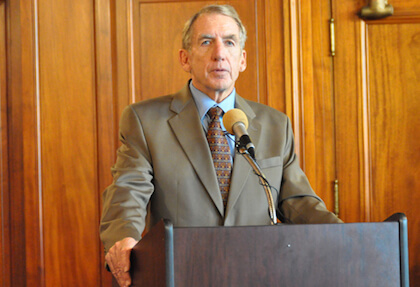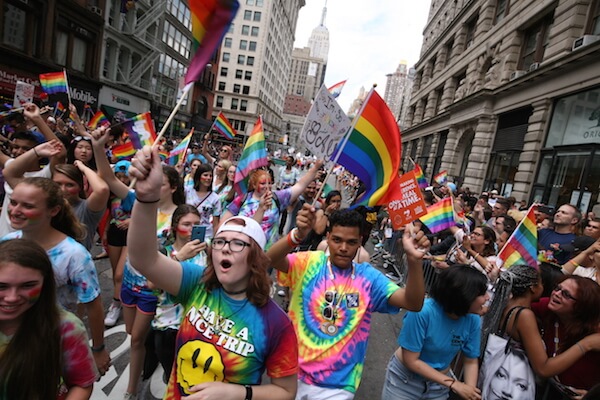ILLUSTRATION BY MICHAEL SHIREY
BY DUNCAN OSBORNE | Let me first say what Jo Becker’s book, “Forcing the Spring: Inside the Fight For Marriage Equality,” is not. Its title, promotional materials, and a few bits of errant prose notwithstanding, this book is not a history of the movement to win marriage rights for same-sex couples in America.
It is the story of the lawsuit brought by the American Foundation for Equal Rights (AFER) that overturned Proposition 8, a 2008 California ballot initiative that amended the State Constitution to bar gay and lesbian couples from marrying there.
Just as important, and as my Gay City News colleague Arthur S. Leonard has noted elsewhere, “Forcing the Spring” is not even history; it is journalism and the only question that confronts us is whether this book is good journalism or bad journalism.
Jo Becker’s Prop 8 chronicle chooses its heroes, co-signs narrative that needs them
Beginning in 2009, Becker enjoyed extraordinary access to the two couples who were the plaintiffs in the case, their attorneys David Boies and Ted Olson, and Chad Griffin and other AFER staff, with the sole restriction being that she could not report what she observed until after the proceedings were done.
Becker sought, but was not given, similar access to Charles Cooper, the attorney who represented the pro-Prop 8 side, and his colleagues and clients. The result, as Becker concedes in a “note on sourcing and other matters,” is that “much of this book is told from the vantage point of the plaintiffs.”
I would say that the entire book is told from the plaintiffs’ perspective and that is a significant flaw in this story. The consequence is that “Forcing the Spring” is a lot of cheerleading from start to finish. Cheerleading has been endemic in the mainstream and gay press coverage of the marriage movement for years, but the author takes it to a whole new level.
PENGUIN BOOKS
As has been widely noted, Becker opens the book by comparing Griffin, now the head of the Human Rights Campaign, the nation’s largest gay lobby, to Rosa Parks, an African American who refused to comply with segregated seating on buses and became an important symbol in the civil rights movement. Griffin rejected that comparison in an editorial in the Advocate. There are other moments in the book where Becker evokes Martin Luther King in an effort to puff up the AFER lawsuit. This sort of rhetoric is lazy and cheap.
The marriage and LGBT rights movements are not vital and important because they resemble some other social justice movement that was noble. These efforts are important because we demonstrate our courage in the face of some tough opponents. The movements show us at our best, I hope, and at our worst. The discrimination we endure is not bad because it resembles some other evil; it is bad because of the harm it does to us and the damage it does to this nation.
To make her protagonists heroic, Becker renders Evan Wolfson, the founder of Freedom to Marry, a pro-marriage group, as an obstacle to progress in the marriage fight. This is ridiculous. Wolfson was among the leading voices, if not the leading voice, that got LGBT legal groups into the marriage business in the first place.
To sustain this hero narrative, the author largely ignores the bold predictions about winning marriage in all 50 states that Olson, Boies, and the AFER team offered before the lawsuit was launched. And she is well aware of that bold talk.
In a 2009 profile of Olson in the New York Times that Becker wrote, she paraphrased him saying the lawsuit “will lead to a Supreme Court decision with the potential to reshape the legal and social landscape along the lines of cases like Brown v. Board of Education and Roe v. Wade: the legalization of same-sex marriage nationwide.”
In 2010, the AFER team won a decision holding that the ban — and, in general terms, any such prohibition — was unconstitutional from Judge Vaughn Walker, following a trial in federal court in San Francisco. The Ninth Circuit, which heard the appeal of that decision, limited that holding so that it would apply narrowly to the situation in California, and, as Becker acknowledges, effectively urged the US Supreme Court to not take the case. In 2013, the nation’s highest court declined to decide the case on the merits, holding instead that the defendants did not have standing to appeal. The result was that Prop 8 was overturned and that was all.
Becker asks no question about this. While the worst nightmares of the LGBT legal groups that opposed the lawsuit were not realized, their assertion that this was not the time to bring a suit to the US Supreme Court was proven correct. Becker does not return to this issue, but just quotes Olson saying, “We won.” According to the standard that Olson presented in 2009 and that Becker reported, they lost.
To Becker’s credit, she shows the AFER campaign in its entirety, though the elements of the campaign that I find objectionable, she sees as brilliant. To her discredit, she never questions or explores what she sees.
The marriage movement is run by lawyers, public relations experts, and political consultants. The rest of us and the couples who are prominently featured in that movement are mere set pieces and pawns to be trotted out when a compelling backdrop is needed for some press event. That unfortunate fact is in full throttle in “Forcing the Spring.”
Author Jo Becker. |PIOTR REDLINSKI/ PENGUIN PRESS
Becker reports that when Griffin and Kristina Schake, his business partner, first began searching for couples to be plaintiffs, they hired an opposition researcher to dig into their backgrounds to make sure there would be no embarrassing revelations about them.
The night before the trial began, the AFER team heard “reports that a man in a wedding dress had shown up at the vigil.” This was “catnip to the camera crews stationed outside but exactly the kind of visuals Chad wanted to avoid. For too long, he felt, the gay rights movement had been defined by flamboyant, off-putting imagery. Men wearing leather chaps and bare-chested women on motorcycles at gay pride parades made the news, but did not reflect the reality of modern gay life.”
I am not the only person who was sickened by the notion that those of us in the “gay rights movement” cannot tell the authentic stories of our lives because that may offend the broader society.
Sandy Stier, who comprised the lesbian plaintiff couple with her partner Kris Perry, had two sons from a prior marriage. When they were profiled in People magazine, Frank, the youngest, “hated the way that the People magazine made them all out to be some kind of modern-day Brady Bunch,” Becker reports.
Later, as they were waiting to learn if the US Supreme Court would hear the case, AFER made plans to hold weddings for the two couples if the court declined to grant cert.
“Kris and Sandy had nixed an AFER-hatched plan to hold a celebrity-studded reception in Los Angeles; San Francisco City Hall would do just fine,” Becker writes.
Ultimately, I wondered if Becker is telling an authentic story or if this book was just one more piece of the Gay Marriage: The Brand marketing campaign that was the Prop 8 trial. And so the answer to my colleague’s question is that this is bad journalism.
FORCING THE SPRING: INSIDE THE FIGHT FOR MARRIAGE EQUALITY | By Jo Becker | Penguin Press | 470 pages | $29.95




































